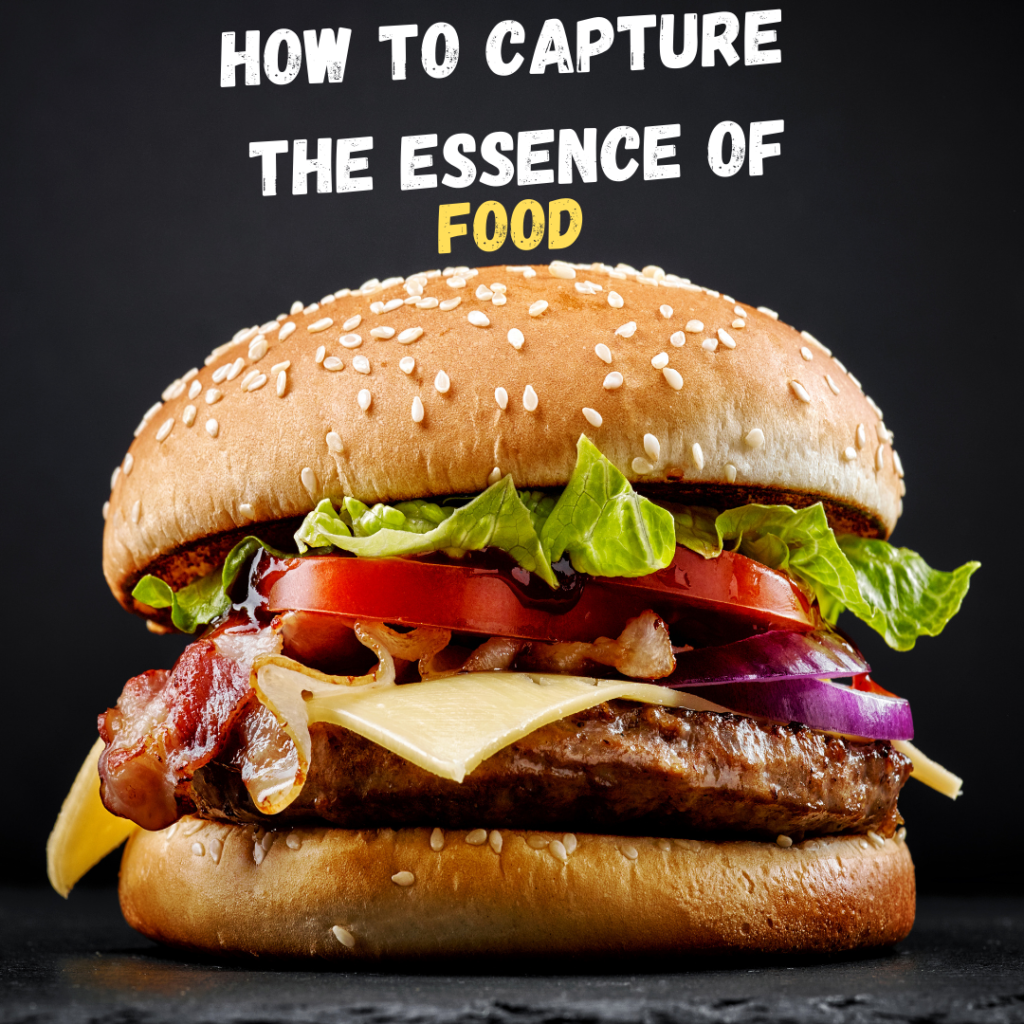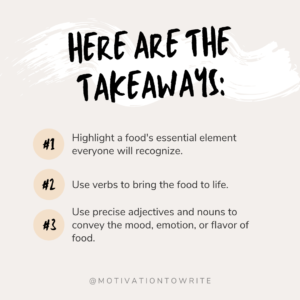Table of Contents
How To Capture the Essence of Food
My guest this week on Motivation To Write is vegan chef Tomi Makanjuola. Her episode got me thinking about how to capture the essence of food with words.
Food writing is an art, just like sports writing or music writing. It helps to have extensive knowledge of your subject. But what if you don’t? Can you still write about or describe food in such a way making your reader’s mouths water?
Yes. Let’s learn how to capture the essence of food. We’re going to look at three examples and figure out how the writers create delicious food imagery.
“Grits”
Our first example is a poem by Angela Jackson called “grits”:
all night
she watch the pot, cooked
her grits thick for hours
(not the quick kind) till grains disappear
into smooth with a slick
coat on top
hot enough
for a man to wear
(she said) on both
his faces.
Ouch! Watch out, man. You’re in for a hot mess tonight! (I got this poem from Cynthia R. Greenlee’s essay, “A Real Hot Mess: How Grits Got Weaponized Against Cheating Men.”)
Back to the point.
Jackson narrows in on one essential element anyone who has ever enjoyed a bowl of steamy grits will recognize: the “slick coat on top.” Because it’s such a simple description, its vitality may elude you. But delete it, and the grits change from delicious, hot, and dangerous to just dangerous.
Charlie and the Chocolate Factory
For our second example for how to capture the essence of food, I turn to one of my favorite childhood books–Roald Dahl’s Charlie and the Chocolate Factory. Although this story is full of delectable images of sweet treats, I want us to look at how Dahl describes these bland meals:
“The only meals they could afford were bread and margarine for breakfast, boiled potatoes and cabbage for lunch, and cabbage soup for supper.”
Talk about uninspired! Yet, I can taste and smell these meals. Dahl uses specific nouns connotating flavorlessness and poverty. Except for “boiled,” he doesn’t use adjectives to embellish the images these words conjure. He doesn’t say “crunchy cabbage” or “wheat bread.” The descriptions are plain, underscoring the bland flavors.
“Bar Omar: Tables for Two”
Contrast Dahl’s meals with this mouth-watering spread from a New Yorker article, “Bar Omar: Tables for Two” by Becky Cooper:
But the tagine (lamb, chicken, or kefta) is the showstopper. Portioned for two, it arrives in a tall clay vessel, clutched between napkins. The waiter pauses for dramatic effect before rolling off the lid, letting steam billow out. If you ordered the lamb, swollen prunes, fat apricots, and egg-shaped potatoes hug two giant shanks sunk in a still-bubbling broth; the prunes collapse into a sweet, jammy mess the second they’re touched. Shovel, some of the fruit over meat, pulled clean from the bone, add slivered almonds for crunch, and it’s a perfect bite. Ending your meal with dessert is a must, and the crème brûlée is irreproachably classic. Shatter the shell of blistered sugar into pieces that look like stained glass and try not to smile.
If that doesn’t make your mouth water, I don’t know what will. I’m a vegetarian, yet my mouth waters every time I read this. Cooper illustrates the show this meal puts on, beginning with its stately entrance in a “tall vessel” and “clutched between napkins,” like a king arriving in a palanquin. As the waiter removes the lid, steam “billows out.” Dramatic indeed!
But it’s the detail with which Cooper describes the food that makes me drool. Unlike Dahl’s lack of adjectives to highlight the tasteless meals of the Bucket family, Cooper chooses adjectives capturing–like Jackson–the essential elements of each food item: “swollen prunes, fat apricots, and egg-shaped potatoes.”
Her use of verbs is also effective. The prunes, apricots, and potatoes “hug” the meat. The prunes “collapse” into a sweet mess. And she implores the reader to “shovel” the fruit over the lamb before taking a bite.
Let’s not forget about dessert. Cooper, again, uses an adjective–” blistered”–to highlight the most recognizable feature of crème brûlée, the burnt sugar. She tells us to “shatter” this shell, comparing its brokenness to “pieces of stained glass”–a vivid simile.
So, here are the takeaways on how to capture the essence of food:
- Highlight a food’s essential element everyone will recognize. Readers love familiarity because it helps paint a clear image in their heads and helps them feel like they can relate to your story.
- Use verbs to bring the food to life. Illustrating food in motion, for example, meat falling off the bone evokes delicious imagery.
- Use precise adjectives and nouns to convey the mood, emotion, or flavor of food. It’s one thing to say, “Mary eats potato chips.” But is she eating thin, plain chips; thick, ruffled chips; or organic chips? If it matters because the chips she eats suggest a character trait or foreshadows an event, be specific.
Cited Works
Dahl, Roald, and Quentin Blake. Charlie and the Chocolate Factory. Illustrated, Puffin Books, 2007.




